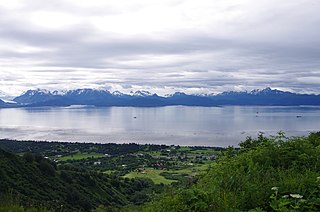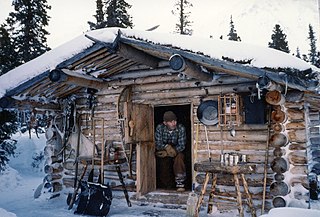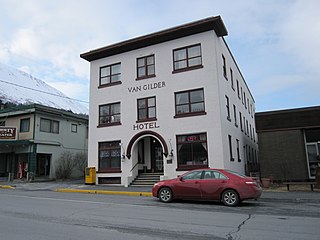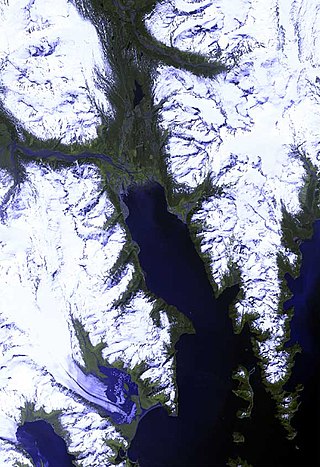
Kenai Peninsula Borough is a borough of the U.S. state of Alaska. As of the 2020 census, the population was 58,799, up from 55,400 in 2010. The borough seat is Soldotna, the largest city is Kenai, and the most populated community is the census-designated place of Kalifornsky.

Prince William Sound is a sound off the Gulf of Alaska on the south coast of the U.S. state of Alaska. It is located on the east side of the Kenai Peninsula. Its largest port is Valdez, at the southern terminus of the Trans-Alaska Pipeline System. Other settlements on the sound, which contains numerous small islands, include Cordova and Whittier plus the Alaska native villages of Chenega and Tatitlek.

Rockwell Kent was an American painter, printmaker, illustrator, writer, sailor, adventurer and voyager.
Sam Keith was an American writer. His most notable work was the 1973 best seller One Man's Wilderness: An Alaskan Odyssey, in which he edited and expanded on the journals of his friend Richard Proenneke's solo experiences in Alaska to create an Alaskan classic. In 2014, Keith's formerly lost manuscript First Wilderness: My Quest in the Territory of Alaska was published.

Kenai Fjords National Park is an American national park that comprises the Harding Icefield, its outflowing glaciers, and coastal fjords and islands. The park covers an area of 669,984 acres on the Kenai Peninsula in south-central Alaska, west of the town of Seward.

Richard Louis Proenneke was an American self-educated naturalist, conservationist, writer, and wildlife photographer who, from the age of about 51, lived alone for nearly thirty years (1968–1998) in the mountains of Alaska in a log cabin that he constructed by hand near the shore of Twin Lakes. Proenneke hunted, fished, raised and gathered much of his own food, and also had supplies flown in occasionally. He documented his activities in journals and on film, and also recorded valuable meteorological and natural data. The journals and film were later used by others to write books and produce documentaries about his time in the wilderness.

Canoe camping, also known as touring, tripping or expedition canoeing, is a combination of canoeing and camping. Canoe campers typically carry enough supplies with them to travel and camp for several days via a canoe.

Chugach State Park covers 495,204 acres covering a hilly region immediately east of Anchorage, in south-central Alaska.

Resurrection Bay, also known as Blying Sound, and Harding Gateway in its outer reaches, is a fjord on the Kenai Peninsula of Alaska, United States. Its main settlement is Seward, located at the head of the bay. The bay received its name from Alexandr Baranov, who was forced to retreat into the bay during a bad storm in the Gulf of Alaska. When the storm settled it was Easter Sunday, so the bay and nearby Resurrection River were named in honor of it. Harding Gateway refers to the passage between Rugged and Cheval Islands.

Robert Christian Boes Hansen, popularly known as the Butcher Baker, was an American serial killer active in Anchorage, Alaska, between 1972 and 1983. Hansen abducted, raped and murdered at least seventeen women. Many of the women abducted were released by Hansen into the wilderness and hunted with a Ruger Mini-14 and hunting knives. Hansen was captured in 1983 and sentenced to 461 years' imprisonment without the possibility of parole. He died in 2014 of natural causes at age 75.

John Ben Benson Jr. was an Alaska Native best known for designing the flag of Alaska. Benson was 14 years old when he won a contest in 1927 to design the flag for the Territory of Alaska, which became a U.S. state on January 3, 1959.

Tracy Arm is a fjord in the U.S. state of Alaska near Juneau. It is named after the Secretary of the Navy Benjamin Franklin Tracy. It is located about 45 miles (72 km) south of Juneau and 70 miles (110 km) north of Petersburg, Alaska, off of Holkham Bay and adjacent to Stephens Passage within the Tongass National Forest. Tracy Arm is the heart of the Tracy Arm-Fords Terror Wilderness, designated by the United States Congress in 1990

Montague Island (Sugpiaq: Suklluurniilnguq) lies in the Gulf of Alaska at the entrance to Prince William Sound, Alaska. The island has a land area of 790.88 km2, making it the 26th largest island in the United States. As of the 2000 census, Montague did not have a permanent resident population, making it at that time the largest uninhabited island in the United States. Since then, the 2010 abandonment of the United States Coast Guard station on Attu Island in the Aleutian Islands, which at 892.8 km2 is larger than Montague Island, causes Attu to claim that title. Montague Island was named by Captain James Cook in honor of John Montagu, 4th Earl of Sandwich, one of his greatest supporters.
Out of the Wild is a Discovery Channel reality television series. The first and second seasons followed volunteers from urbanized backgrounds as they use survival skills in the back-country of Alaska during the fall and winter. The third season saw a relocation of the series to Venezuela, while keeping the same general format of season 2. The series was produced by Ricochet in the first season, and by Pilgrim Films in seasons 2 and 3.

The Van Gilder Hotel is a historic multipurpose commercial and civic building at 307 Adams Street in Seward, Alaska, United States.
Fort McGilvray was a United States military fortification located on Caines Head, a cliff 650 feet above Resurrection Bay south of Seward, Alaska. The United States Army established a series of defensive positions along the coast of the bay during World War II to defend Seward against a possible Japanese invasion. The bay was a strategically important location, as it remained ice-free throughout the year, and Seward served as the southern terminus of the Alaska Railroad, an important route for transporting civilian and military supplies throughout the territory.

Baranof Island is an island in the northern Alexander Archipelago in the Alaska Panhandle, in Alaska. The name "Baranof" was given to the island in 1805 by Imperial Russian Navy captain U. F. Lisianski in honor of Alexander Andreyevich Baranov. It was called Sheet’-ká X'áat'l by the native Tlingit people. It is the smallest of the ABC islands of Alaska. The indigenous group native to the island, the Tlingit, named the island Shee Atika. Baranof island is home to a diverse ecosystem, which made it a prime location for the fur trading company, the Russian American Company. The Russian occupation of Baranof Island impacted not only the indigenous population and the ecology of the island, but also led to the United States' current ownership over the land.

Edgar Walker was an American veteran of World War II, businessman, publisher and writer. Walker was the penultimate surviving member of "Castner's Cutthroats", a regiment consisting of sixty-five men who performed reconnaissance missions in the Aleutian Islands during World War II. Castner's Cutthroats was the unofficial name of the 1st Alaskan Combat Intelligence Platoon.

Caines Head State Recreation Area is a 6,571-acre (26.59 km2) recreational area encompassing the Caines Head cape in Resurrection Bay, Alaska. The area is located in the Kenai Peninsula Borough, 7 miles (11 km) south of the city of Seward. A popular tourist destination, Caines Head features spruce and hemlock forests as well as a variety of terrestrial and marine wildlife. It also features the remains of Fort McGilvray, a World War II-era fortification erected in 1941–1942 to defend against the potential invasion of the Imperial Japanese Army.

Mount Ascension is a prominent 5,710-foot (1,740 m) mountain summit located in the Kenai Mountains, on the Kenai Peninsula, in the U.S. state of Alaska. The mountain is situated in Chugach National Forest, 6.8 mi (11 km) south of Mount Adair, 3.5 mi (6 km) north of Resurrection Peaks, and 10 mi (16 km) north of Seward, Alaska. The peak is near the mouth of Resurrection River into Resurrection Bay. The name Resurrection, referring to the Resurrection of Jesus, is overused for nearby landforms on the Kenai peninsula, as the mountain to the immediate south is Resurrection Peaks. This Ascension name is a variation of the theme. Mount Ascension's name was proposed in 1968 by the Mountaineering Club of Alaska, and officially adopted in 1969 by the United States Geological Survey. Access to the peak is via the Lost Lake Trail, and mountaineering skills are needed to reach the summit. In clear weather the immense Harding Icefield can be seen from the top. The first ascent of this peak was made October 6, 1968, by John Vincent Hoeman and his wife, Dr. Grace (Jansen) Hoeman.


















